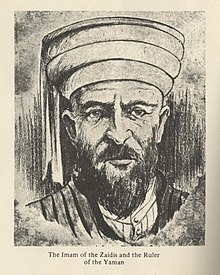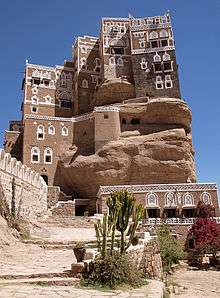Yahya Muhammad Hamid ed-Din
Yahya Muhammad Hamid ed-Din (or Imam Yahya) (Arabic: يحيى محمد حميد الدين, 18 June 1869 – 17 February 1948) became Imam of the Zaydis in 1904 after the death of his father, Muhammad Al-Mansur,[1] and Imam of Yemen in 1918. His name and title in full was "His majesty Amir al-Mumenin al-Mutawakkil 'Ala Allah Rab ul-Alamin Imam Yahya bin al-Mansur Bi'llah Muhammad Hamidaddin, Imam and Commander of the Faithful" (the prince of the believers, he who relies on God, the Lord of the Universe).
| Imam Yahya Hamididdin
Arabic: الامام المتوكل على الله يحيى | |
|---|---|
 Portrait of Yahya by Ameen Rihani, 1922. Imam Yahya steadfastly refused to be photographed throughout his life. | |
| Imam of Yemen | |
| Reign | 4 June 1904 – 17 February 1948 |
| Predecessor | Muhammad bin Yahya Hamid ad-Din |
| Successor | Ahmad bin Yahya |
| Born | 18 June 1869 Sana'a, Eyalet-i Yemen |
| Died | 17 February 1948 (aged 78) Sana'a, Yemen |
| Issue | Ahmad bin Yahya Mohammed bin Yahya (drowned in the Red Sea) Hassan bin Yahya Ali bin Yahya Abdullah bin Yahya (executed) Ibrahim bin Yahya Ismail bin Yahya Al-Qasim bin Yahya Yahya bin Yahya Abdel-Rahman bin Yahya Almtehr bin Yahya Mohsen bin Yahya Al-Abbas bin Yahya (executed) Hussein bin Yahya |
| House | Rassids |
| Father | Muhammad bin Yahya Hamid ad-Din |
| Religion | Zaidi Islam |
Yahya Muhammad Hamid ed-Din was born on Friday 18 June 1869 in Sanaa into the Hamidaddin branch of the al-Qasimi dynasty who ruled most of Yemen proper and South Saudi Arabia today for over 900 years. Upon the death of his father in 1904, Yahya became Imam, effectively ruler over the mountainous areas of the future North Yemen. However, the Ottomans who made claim on the area did not recognize the rule of the Imams of Yemen since their entry into Yemen.
Impressions
Sir Gilbert Clayton, who visited King Yahya in Sana'a in an earnest attempt to win him over in 1925 and during his short stay in the capital, was impressed by this ruler's administration, his military preparedness, and organization.
Lt Col. Harold Jacob, C.S.I. describing him said; "Imam Yahya is a strong ruler. His sanctity as High Priest of the Zaidi sect and his descent from the Prophet's family adds to the prestige which his benign rule has won. His methods are patriarchal and humane. His one hobby is the Yemen"
Jewish chronicles lavish praise upon him and depict him as the champion of justice and compassion.[2] This is, however, not surprising. Imam Yahia managed to put an end to the state of anarchy, lawlessness and violence which had lacerated the country and inflicted immense suffering upon its inhabitants, including the Jews. During his long reign the Jews enjoyed relatively favorable conditions and were generally in favour of the Imam.[3]

World War I
In 1911 Imam Yahya signed the Treaty of Daan with the Ottomans which recognised his rule over the Zaydi-controlled portions of Yemen.[4]
News of the demise of the Ottoman Empire reached Yemen on Thursday 14 November 1918. Imam Yahya went to Sana'a three days later on Sunday 17 November 1918 to meet with tribal leaders from Hashid, Arhab, Nihm, and Khowlan. He arrived at the residence of the judge and scholar Hussein bin Ali Al Amri and received dignitaries, scholars, Turkish princes, judges, and a flood of subjects who proclaimed him the supreme ruler of all of Yemen.
His first order was to forbid entering the capital Sana'a with arms, and appointed sentries at the gates to start a reign of peace and justice unparalleled during the years of his rule. City after city accepted the rule and authority of Imam Yahya; the port of Mocha, and the city of Taiz were among the first most important cities. He took steps to create a modern state, and maintained all Ottoman officials who would stay to support the development of government.
He created a regular army in 1919 that enlisted soldiers from the surrounding tribes to Sana'a; from the tribes of Sanhan, Bani Harthi, and Bani Hushaish. He signed many treaties which recognised Yemen as a sovereign state, the first of which was the Italo-Yemeni Treaty in 1926.
Due to conflicting tribes in the border areas between Saudi Arabia and Yemen that escalated into a war ensued that was ended in 1934 with the signing of the Taif Treaty between Saudi Arabia and Yemen. The treaty was the basis for the final territorial agreement between both countries concluded during the reign of King Fahd bin Abdulaziz and President Ali Abdullah Saleh.
Internal policy
From 1934 until his assassination in 1948, Yahya redirected his energies toward internal consolidation of his authority and the creation of a viable central government, answerable to him personally. To this end, control of the hinterland was strengthened by the establishment of a standing army and the naming of his sons as governors of key provinces. Tighter control over affairs in San'a, the capital, was assured by expanding the scope of administrative functions and appointing other sons as supervisors of old and new political institutions . The regime sent Yemen's first students abroad : military cadets to Iraq in the 1930s and civilian students, the "Famous Forty," to Lebanon in the late 1940s.[5] An early attempt was made to introduce some direction to the nascent national economy by the establishment of a Yemen trading company.[6] Even with these changes, Yahya's Yemen was a semi-feudal state in which even the most basic measures required his personal approval.
Relations with his Jewish subjects
Imam Yahya was largely admired by the Jews of Yemen, who saw him as their patron and protector.[7] Earlier, in 1906, the Jews of Sana'a had come out in full-force to welcome the Imam who returned to the city after the Turks had temporarily left it. However, by 1922, in response to outside pressure, Imam Yahya promulgated an edict that prohibited Yemeni Jewish emigration. Although the ban on emigration remained the official policy of the state until 1949, Jews were able to bypass its policy by secretly going into the British Protectorate of Aden. Throughout the early 1940s, Imam Yahya turned a blind eye to Jewish emigration, neither prohibiting it nor officially permitting it, but rather giving his unspoken consent to the departure of Jews from Sana'a and other central Yemeni settlements.[8] During the Imam's reign, he reinforced an old edict prohibiting Jews from building their houses higher than Muslim houses.[9] The Imam appointed Yihya Yitzhak Halevi as one of four representatives of the Jewish community, responsible for conveying matters of state to his community and collecting the annual Poll-tax, a position which he held until his death.[10] After the Imam's assassination in 1948, the king's emigration policy continued under his son Ahmad.
Assassination
During a short excursion outside of the periphery of Sana'a on 17 February 1948, the Imam's limousine was ambushed by an assassin, during which the Imam Yahya and his grandson were shot and killed, in what became known as the Alwaziri coup. The assassin, known as Al-Qardaei, was from the Bani Murad tribe.
Upon the knowledge of the murder of Imam Yahya, Yemeni tribes rallied behind Sayf-ul-Islam Ahmad bin Yahya and accepted him as the new Imam of Yemen. The armies surrounded Sanaa under the leadership of Seif Ul Islam Alhassan and Seif Ul Islam Alabbass, both sons of the late Imam, supported by their brother Seif Ul Islam Yahya from within the city walls.
The news shocked both the Arab League, and all Muslim governments. King Abdullah of Jordan compared his death to that of the third Caliph Uthman.
Both King Abdulaziz Ibn Saud of Saudi Arabia, and himself supported Imam Ahmad, and were first to declare him as the new Head of State.
Yemen was a founding member of the Arab League in 1945, and later joined the United Nations in 1947.
In 1946 British opposition to Imam Yahya was led from Aden-based political parties.
He had 14 sons:
- 1. Imam Ahmed
- 2. Mohammed Albader
- 3. Alhassan
- 4. Alhussein
- 5. Ali
- 6. Al-Motahar
- 7. Al-Qassim
- 8. Abdullah
- 9. Ibrahim
- 10. Ismail
- 11. Alabbas
- 12. Yahya
- 13. Al-Mohsin
- 14. Abdulrahman [11][12]
References
- Western Arabia and the Red Sea, Naval Intelligence Division, London 2005, p. 287 ISBN 0-7103-1034-X
- Shalom 'Uzayri, Galei-Or, Tel-Aviv 1974 (Hebrew)
- Parfitt, Tudor (2000) 'The Jewish Image of the Imam: Paradox or Paradigm?' In: Parfitt, Tudor, (ed.), Israel and Ishmael: Studies in Muslim-Jewish relations. London: Curzon-SOAS Near and Middle East Publications, pp. 207–225.
- Robert Burrowes, Historical Dictionary of Yemen (Lanham: Scarecrow Press, Inc., 1995), xxvi.
- see Burrowes, Robert D. (Winter 2005). "The Famous Forty and Their Companions: North Yemen's First-Generation Modernists and Educational Emigrants". Middle East Journal. 59 (1): 81–97. JSTOR 4330098. – via JSTOR (subscription required)
- Legitimacy and political change in Yemen and Oman, J. E. Peterson
- Bat-Zion Eraqi Korman, "Yemeni Jews En Route to Palestine by Way of Aden during the Mandate Period 1920–1948", in: Ascending the Palm Tree – An Anthology of the Yemenite Jewish Heritage, Rachel Yedid & Danny Bar-Maoz (ed.), E'ele BeTamar: Rehovot 2018, p. 309 OCLC 1041776317
- Bat-Zion Eraqi Korman, "Yemeni Jews En Route to Palestine by Way of Aden during the Mandate Period 1920–1948", in: Ascending the Palm Tree – An Anthology of the Yemenite Jewish Heritage, Rachel Yedid & Danny Bar-Maoz (ed.), E'ele BeTamar: Rehovot 2018, pp. 310–313 OCLC 1041776317
- Rathjens, Carl (1957). Jewish Domestic Architecture in San'a, Yemen. Jerusalem: The Israel Oriental Society, affiliate of the Hebrew University. p. 14. OCLC 48323774.; as early as 1761, Yemeni Imam el-Mahdi el-Abbas (1748–1775) ordered that the Jews in Sana'a lower their houses to a maximum height of 14 cubits (nine metres)
- Shalom Gamliel, The Jews and the King in the Yemen, vol. 1-2, pp. 19-20, Jerusalem 1986 (Hebrew)
- 10 years in the life of Imam Yahya Mohammed Hamidaddin by Dr. Mohammed Essa Salehia
- http://www.izabacf.org
External links
- Imam Yahya Hamid ad-Din Painted by Ameen Albert Rihani Source: kings of the Arabs
- http://www.hamidaddin.net
Yahya Muhammad Hamid ed-Din Cadet branch of the Tabatabaei | ||
| Preceded by Muhammad bin Yahya Hamid ad-Din |
Imam of Yemen 1904–1948 |
Succeeded by Ahmad bin Yahya |
| Preceded by none |
King of Yemen 1918–1948 |
Succeeded by Ahmad bin Yahya |